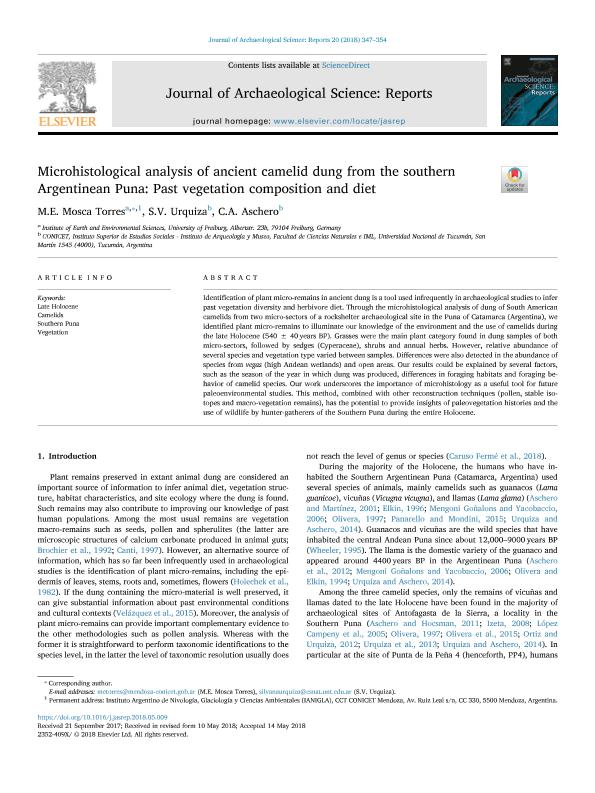Mostrar el registro sencillo del ítem
dc.contributor.author
Mosca Torres, Maria Eugenia

dc.contributor.author
Urquiza, Silvana Valeria

dc.contributor.author
Aschero, Carlos Alberto

dc.date.available
2019-10-25T20:18:33Z
dc.date.issued
2018-08
dc.identifier.citation
Mosca Torres, Maria Eugenia; Urquiza, Silvana Valeria; Aschero, Carlos Alberto; Microhistological analysis of ancient camelid dung from the southern Argentinean Puna: Past vegetation composition and diet; Elsevier; Journal of Archaeological Science: Reports; 20; 8-2018; 347-354
dc.identifier.issn
2352-409X
dc.identifier.uri
http://hdl.handle.net/11336/87305
dc.description.abstract
Identification of plant micro-remains in ancient dung is a tool used infrequently in archaeological studies to infer past vegetation diversity and herbivore diet. Through the microhistological analysis of dung of South American camelids from two micro-sectors of a rockshelter archaeological site in the Puna of Catamarca (Argentina), we identified plant micro-remains to illuminate our knowledge of the environment and the use of camelids during the late Holocene (540 ± 40 years BP). Grasses were the main plant category found in dung samples of both micro-sectors, followed by sedges (Cyperaceae), shrubs and annual herbs. However, relative abundance of several species and vegetation type varied between samples. Differences were also detected in the abundance of species from vegas (high Andean wetlands) and open areas. Our results could be explained by several factors, such as the season of the year in which dung was produced, differences in foraging habitats and foraging behavior of camelid species. Our work underscores the importance of microhistology as a useful tool for future paleoenvironmental studies. This method, combined with other reconstruction techniques (pollen, stable isotopes and macro-vegetation remains), has the potential to provide insights of paleovegetation histories and the use of wildlife by hunter-gatherers of the Southern Puna during the entire Holocene.
dc.format
application/pdf
dc.language.iso
eng
dc.publisher
Elsevier

dc.rights
info:eu-repo/semantics/openAccess
dc.rights.uri
https://creativecommons.org/licenses/by-nc-nd/2.5/ar/
dc.subject
CAMELIDS
dc.subject
LATE HOLOCENE
dc.subject
SOUTHERN PUNA
dc.subject
VEGETATION
dc.subject.classification
Arqueología

dc.subject.classification
Historia y Arqueología

dc.subject.classification
HUMANIDADES

dc.title
Microhistological analysis of ancient camelid dung from the southern Argentinean Puna: Past vegetation composition and diet
dc.type
info:eu-repo/semantics/article
dc.type
info:ar-repo/semantics/artículo
dc.type
info:eu-repo/semantics/publishedVersion
dc.date.updated
2019-10-16T20:57:11Z
dc.journal.volume
20
dc.journal.pagination
347-354
dc.journal.pais
Países Bajos

dc.journal.ciudad
Amsterdam
dc.description.fil
Fil: Mosca Torres, Maria Eugenia. University of Freiburg; Alemania
dc.description.fil
Fil: Urquiza, Silvana Valeria. Universidad Nacional de Tucumán. Facultad de Ciencias Naturales e Instituto Miguel Lillo. Instituto de Arqueología y Museo; Argentina. Consejo Nacional de Investigaciones Científicas y Técnicas; Argentina
dc.description.fil
Fil: Aschero, Carlos Alberto. Universidad Nacional de Tucumán. Facultad de Ciencias Naturales e Instituto Miguel Lillo. Instituto de Arqueología y Museo; Argentina. Consejo Nacional de Investigaciones Científicas y Técnicas; Argentina
dc.journal.title
Journal of Archaeological Science: Reports
dc.relation.alternativeid
info:eu-repo/semantics/altIdentifier/url/https://www.sciencedirect.com/science/article/pii/S2352409X17306399
dc.relation.alternativeid
info:eu-repo/semantics/altIdentifier/doi/https://doi.org/10.1016/j.jasrep.2018.05.009
Archivos asociados
